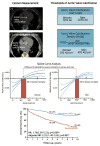Impact of aortic valve calcification, as measured by MDCT, on survival in patients with aortic stenosis: results of an international registry study
- PMID: 25236511
- PMCID: PMC4391203
- DOI: 10.1016/j.jacc.2014.05.066
Impact of aortic valve calcification, as measured by MDCT, on survival in patients with aortic stenosis: results of an international registry study
Abstract
Background: Aortic valve calcification (AVC) load measures lesion severity in aortic stenosis (AS) and is useful for diagnostic purposes. Whether AVC predicts survival after diagnosis, independent of clinical and Doppler echocardiographic AS characteristics, has not been studied.
Objectives: This study evaluated the impact of AVC load, absolute and relative to aortic annulus size (AVCdensity), on overall mortality in patients with AS under conservative treatment and without regard to treatment.
Methods: In 3 academic centers, we enrolled 794 patients (mean age, 73 ± 12 years; 274 women) diagnosed with AS by Doppler echocardiography who underwent multidetector computed tomography (MDCT) within the same episode of care. Absolute AVC load and AVCdensity (ratio of absolute AVC to cross-sectional area of aortic annulus) were measured, and severe AVC was separately defined in men and women.
Results: During follow-up, there were 440 aortic valve implantations (AVIs) and 194 deaths (115 under medical treatment). Univariate analysis showed strong association of absolute AVC and AVCdensity with survival (both, p < 0.0001) with a spline curve analysis pattern of threshold and plateau of risk. After adjustment for age, sex, coronary artery disease, diabetes, symptoms, AS severity on hemodynamic assessment, and LV ejection fraction, severe absolute AVC (adjusted hazard ratio [HR]: 1.75; 95% confidence interval [CI]: 1.04 to 2.92; p = 0.03) or severe AVCdensity (adjusted HR: 2.44; 95% CI: 1.37 to 4.37; p = 0.002) independently predicted mortality under medical treatment, with additive model predictive value (all, p ≤ 0.04) and a net reclassification index of 12.5% (p = 0.04). Severe absolute AVC (adjusted HR: 1.71; 95% CI: 1.12 to 2.62; p = 0.01) and severe AVCdensity (adjusted HR: 2.22; 95% CI: 1.40 to 3.52; p = 0.001) also independently predicted overall mortality, even with adjustment for time-dependent AVI.
Conclusions: This large-scale, multicenter outcomes study of quantitative Doppler echocardiographic and MDCT assessment of AS shows that measuring AVC load provides incremental prognostic value for survival beyond clinical and Doppler echocardiographic assessment. Severe AVC independently predicts excess mortality after AS diagnosis, which is greatly alleviated by AVI. Thus, measurement of AVC by MDCT should be considered for not only diagnostic but also risk-stratification purposes in patients with AS.
Keywords: Doppler echocardiography; aortic valve calcification; aortic valve stenosis; multidetector computed tomography; survival.
Copyright © 2014 American College of Cardiology Foundation. Published by Elsevier Inc. All rights reserved.
Figures






Comment in
-
Between a rock and a hard place.J Am Coll Cardiol. 2014 Sep 23;64(12):1214-6. doi: 10.1016/j.jacc.2014.07.021. J Am Coll Cardiol. 2014. PMID: 25236512 No abstract available.
References
-
- Bonow RO, Carabello BA, Kanu C, et al. ACC/AHA 2006 guidelines for the management of patients with valvular heart disease: a report of the American College of Cardiology/American Heart Association Task Force on Practice Guidelines (writing committee to revise the 1998 Guidelines for the Management of Patients With Valvular Heart Disease): developed in collaboration with the Society of Cardiovascular Anesthesiologists: endorsed by the Society for Cardiovascular Angiography and Interventions and the Society of Thoracic Surgeons. J Am Coll Cardiol. 2006;48:e1–148. - PubMed
-
- Vahanian A, Alfieri O, Andreotti F, et al. Guidelines on the management of valvular heart disease (version 2012) Eur Heart J. 2012;33:2451–96. - PubMed
-
- Ross J, Jr, Braunwald E. Aortic stenosis. Circulation. 1968;38:61–7. - PubMed
-
- Otto CM. Calcific aortic valve disease: outflow obstruction is the end stage of a systemic disease process. Eur Heart J. 2009;30:1940–2. - PubMed
-
- Iung B, Baron G, Butchart EG, et al. A prospective survey of patients with valvular heart disease in Europe: the Euro Heart Survey on Valvular Heart Disease. Eur Heart J. 2003;24:1231–43. - PubMed
Publication types
MeSH terms
Supplementary concepts
Grants and funding
LinkOut - more resources
Full Text Sources
Other Literature Sources
Medical
Research Materials

